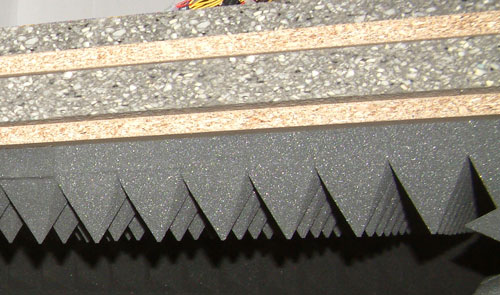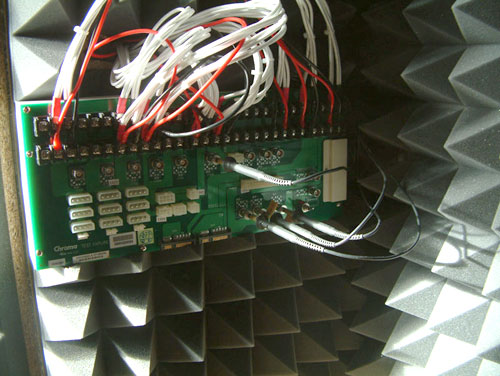Exclusive: Antec Signature 850W
by Christoph Katzer on May 7, 2008 2:00 AM EST- Posted in
- Cases/Cooling/PSUs
Testing with the Chroma ATE Programmable Load

Our test equipment consists of two Chroma programmable DC Loads that enable us to test power supplies with an output of up to 1500W. The biggest advantage of the Chroma DC Loads is simply the high precision it provides. It can measure differences as small as 0.001V and 0.0001A, which will provide us with best-in-class results.
When programming the Chroma with specific amounts of load calculated according to the ATX norm, we are able to load power supplies to an exact percentage. We can now show results at every specific percentage needed. To get the best overview of a power supply, we load each unit with 10%, 20%, 50%, 80%, 100%, and 110% of the specified output. This is easy to calculate for a 1000W power supply: the 10% load is 100W and 110% load is 1100W. Remember that this is the amount of power the PSU delivers; due to inefficiencies, a power supply will actually draw more power from the wall.
Note: If you would like to know more about our testing methodology, equipment, and environment, please read our PSU testing overview.
We have added an additional 10% on the highest load to see how the units perform with overload. This test will be performed in all future reviews. The overload test is performed at room temperature as well as under more stressful conditions; to ensure we are not too cruel to the power supplies, we will keep the ambient temperature at 50°C in the stress test. Experience shows that many units can stand the overload at room temperature but will experience problems with higher temperature and overload together. Only the best-built units will survive this.

The Testing Environment
There is one flaw in testing power supplies with programmable loads while trying to measure the sound pressure levels at the same time. Because the programmable loads get very loud, there is no chance of hearing the power supply on the test stand. In order to make accurate measurements of the noise levels we needed a way to separate the test unit and the programmable loads. Our solution was to build a very thick box around the unit.

We concluded that a five-layer box with a total thickness of 6" (15cm) containing two layers of wood and three layers of special foam would suffice. It is designed as a box within a box. The inner box does not touch any part of the outer box, making it difficult for acoustic noise to pass through in the form of vibration. Each box is isolated on both sides with a layer of heavy foam that is normally used to insulate engines. On the inside we have an additional layer of 4" (10cm) thick pyramidal foam on every side of the box to eliminate the acoustic waves coming from the test object as well as we can.

To ensure a completely closed system we installed the printed circuit board that the connectors of the power supply are attached to inside the anechoic room/box. In other box designs, you would need to put all the cables through the wall. Unfortunately, that would result in the inside of the box not being fully isolated anymore. Our design keeps everything that needs to be connected inside of the box and maintains isolation.










23 Comments
View All Comments
PeteRoy - Monday, May 12, 2008 - link
Power supplies might be a very critical component in the system but they are also the most boring component.I thought power supplies reviews are only found in unpopular computer websites.
hansmuff - Friday, May 9, 2008 - link
"Looking at performance, we saw voltage drops on the lower voltage rails as well as on the 12V rails. All of the rails perform well within specs but a drop of up to 5% is not small.""The Signature series definitely left its mark today with very good performance"
Huh? If I dish out that much money for a power supply, I will not even consider one that drops 5%. And how can that be called "very good performance"?
This PSU has some good characteristics, but my take-away from your review is "don't bother with this until (1) the voltage drop problem is verified to be fixed and (2) it drops not voltages, but $100 off it's price".
mindless1 - Tuesday, May 13, 2008 - link
There is no reason to reject a power supply for 5% drop. Specs exist for a reason, that the powered components MUST also perform properly within the spec.What do you feel you gain with a PSU that has a hypothetically perfect 0% drop? Absolutely nothing. The drop is even less significant today with fewer and fewer parts directly powered by 12, 5, or 3.3V rails. Instead most now have buck conversion inbetween that can accept far more than 10%, letalone 5% deviation.
I do agree the price is a little excessive, although if someone is spending enough to actually need a PSU best at 400W+ output level, they have spent quite a lot on the rest of their system as well. Many overclocked non-SLI gaming systems stay far below 300W consumption.
deathwalker - Friday, May 9, 2008 - link
This review certainly goes against the tide when it come to my experience with Antec over the last 10 yrs. My experience has led me to the feeling that when I bought a Antec product the results was generally that it was overpriced and it under performed.mongoosesRawesome - Wednesday, May 7, 2008 - link
This seems completely overkill except for maybe triple SLI setups - which are also overkill.A good 500W PSU or even less should be plenty even for even mid/high end setups.
Efficiency is all well and good, but if people end up buying large PSU's which aren't efficient at the lower wattage's it's all just for show.
eetnoyer - Wednesday, May 7, 2008 - link
power supply reviews for less than 5% of people who will ever need them (eg. care)? I would venture to guess that the number of users that are in the market to build a nice HTPC and are looking for a quiet low output power supply is greater than the number of ubersuperultramaxgodofgear power supply users.MrOblivious - Thursday, May 8, 2008 - link
Because no one cares. Seriously. It is the same reason why you see people looking at, reviewing, and talking about a Porsche when less than 5% of people will buy one. People don't read about random run of the mill power supplies so it makes no sense to produce reviews people won't read for the website or the brands themselves. Sorry.strikeback03 - Thursday, May 8, 2008 - link
People might read about the Porsche for fun, but they check Consumer Reports when they are trying to decide between an Accord and a Taurus. In this case I'd guess even fewer people care about the high-end power supply than the high-end car - a power supply isn't that exciting until it powers something else you have.The bigger reason is that the companies that send power supplies for review tend to send their biggest and "best".
MrOblivious - Thursday, May 8, 2008 - link
Those assumptions would be incorrect. I literally have companies begging me to take lower powered products in for review all the time and from the page counts people DO NOT read the lower powered offerings. It really is quite simple.strikeback03 - Friday, May 9, 2008 - link
Well, I suppose Johan could be lying when he states that the companies only prefer to send him big units. And I suppose the companies could be sending people to the comments here to ask in every review of big power supplies for reviews of smaller units.